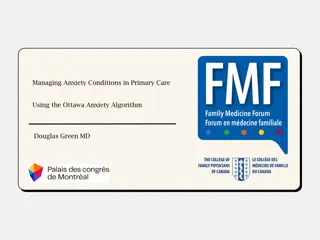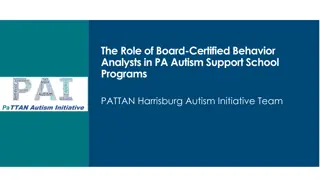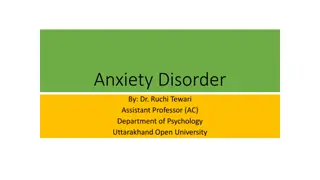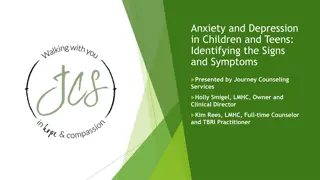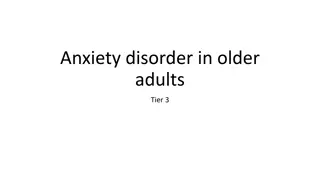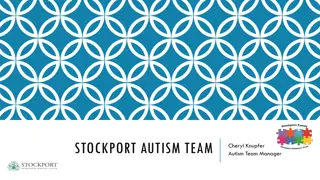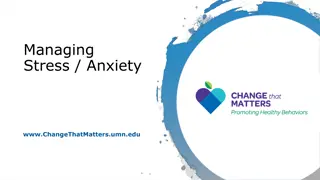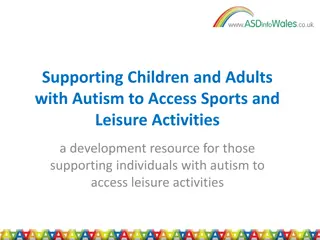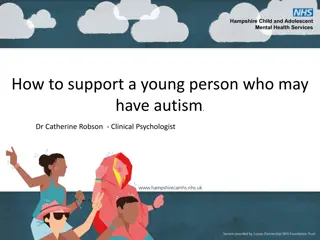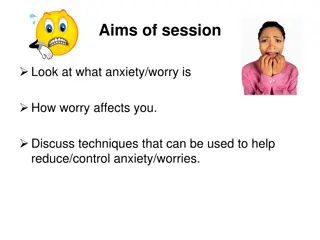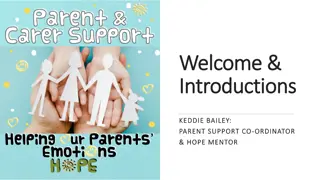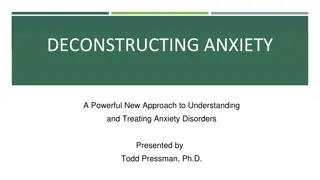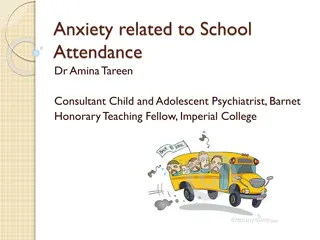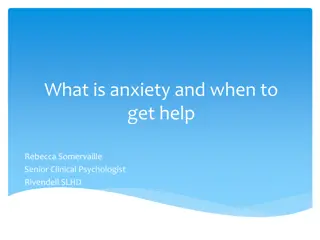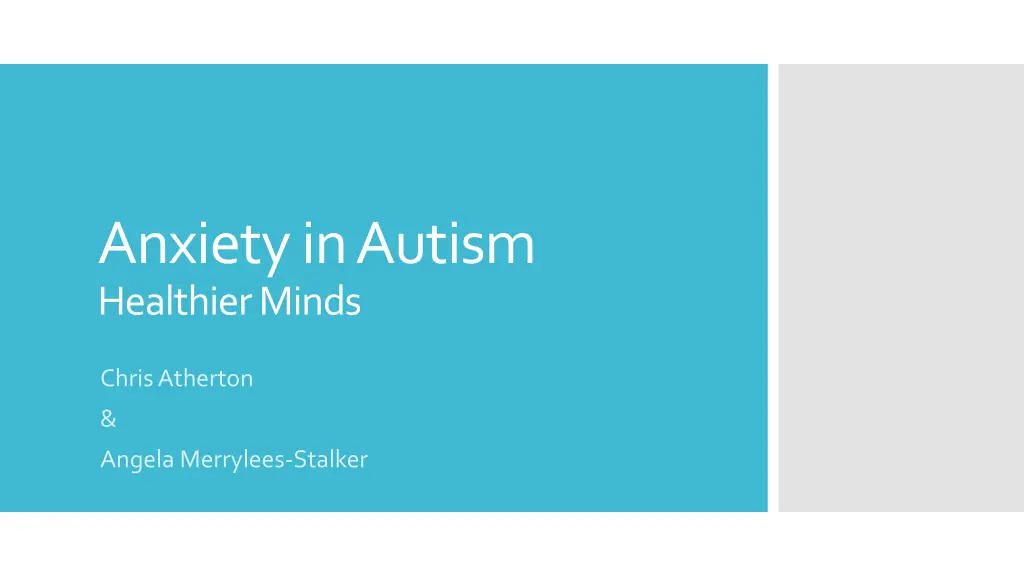
Understanding Anxiety in Autism: Insights into Cognitive Differences
Explore the intricate relationship between anxiety and autism, delving into the challenges of social interaction, cognitive rigidity, and sensory behaviors faced by individuals on the autism spectrum. Discover key theories like Central Coherence Theory and Executive Function Theory, shedding light on the unique experiences and emotions of those with autism. Gain insights into managing triggers, escalation phases, and recovery strategies to provide support for children and young people navigating these complexities.
Uploaded on | 2 Views
Download Presentation

Please find below an Image/Link to download the presentation.
The content on the website is provided AS IS for your information and personal use only. It may not be sold, licensed, or shared on other websites without obtaining consent from the author. If you encounter any issues during the download, it is possible that the publisher has removed the file from their server.
You are allowed to download the files provided on this website for personal or commercial use, subject to the condition that they are used lawfully. All files are the property of their respective owners.
The content on the website is provided AS IS for your information and personal use only. It may not be sold, licensed, or shared on other websites without obtaining consent from the author.
E N D
Presentation Transcript
Anxiety in Autism Healthier Minds Chris Atherton & Angela Merrylees-Stalker
Autism Spectrum Disorder persistent difficulties with social communication and social interaction DSM V restricted and repetitive patterns of behaviours, activities or interests (this includes sensory behaviour) present since early childhood, to the extent that these limit and impair everyday functioning Source: NAS
Temple Grandin Fear is the main emotion in autism
Temple Grandin
Central Coherence Theory Extreme Male Brain Theory Executive Function Theory Theory of Mind Context Blindness Theory MonotropismTheory Patterns of Cognitive Difference in Autism Spectrum Conditions
The social world becomes extremelydifficult for the person to navigate Attempts to communicate are misinterpreted by others Attempts to understand the communication of others is undermined Result A system for navigating the social world is not effective / consistent enough The social world is a place where I am not safe fear, anxiety, stress = cognitive rigidity Less options to choose from most effective is to sabotage = I AM BACK IN CONTROL
The brain and behaviour: anatomy of a hijack FIGHT OR FLIGHT, FREEZE, RESPONSE Heart rate and blood pressure increase. Large muscles prepare for action
Trigger Phase Escalation Phase Crisis Phase Recovery Phase Post Crisis Phase Learning Phase Outburst Additional Incident A R O U S A L The Escalation Aggression Anger Anxiety Baseline Behaviour Exhaustion Time
These children and young people are often carrying a very heavy load
Keep things visual Understand their sensory needs Enhanced the structure Break tasks down Time to process Make it easier Tell them why Support change and transition Gradual exposure Make it logical Teach for each context Autism Specific Considerations (That can help just about anyone)
Clear and consistent language Special interests Make them feel useful and capable Highlight your own mistakes and recovery Backward learning Indirect praise Depersonalise the situation: Use rules to your advantage, e.g. I have a dress code for work, because those are the rules of the system. Autism Specific Considerations (That can help just about anyone)
Managing anxiety driven controlling behaviour
Avoid dominating eye contact Avoid jaw tension Divert attention Keep calm or at least be aware of your emotions When they step backwards do the same Step backwards in demanding situations give the person space Sometimes the hardest, but best thing to do is nothing Don t stand opposite toe to toe (a little on the side) The Low Arousal Approach
Sit down when the person is agitated Avoid a marked body language arms folded or fingers pointing Pretend to be walking home from the pub Avoid being infected by the person s tension Make sure your calm is contagious Wait- it is often enough Make other people leave Avoid touching with tense muscles Relax when somebody grabs you The Low Arousal Approach
Pathological demand avoidance (PDA) is increasingly, but not universally, accepted as a behaviour profile that is seen in some individuals on the autism spectrum. driven to avoid everyday demands and expectations to an extreme extent. This demand avoidant behaviour is rooted in an anxiety-based need to be in control. Pathological Demand Avoidance NAS 2017
People with PDA can appear to have better social understanding and communication skills than others on the autism spectrum, and are often able to use this to their advantage. However, they might not really have as good an understanding of social matters as it seems. PDA as Atypical ASD
resists and avoids the ordinary demands of life uses social strategies as part of avoidance, egdistracting, giving excuses appears sociable, but lacks understanding experiences excessive mood swings and impulsivity Distinctive Features appears comfortable in role play and pretence displays obsessive behaviour that is often focused on other people. appear controlling and dominating, especially when they feel anxious. can be enigmatic and charming when they feel secure and in control. There are underlying neurological differences...
Use Less Direct Demands Try challenges Bet I can get my coat on before you! or Can you show me .. I wonder if we can... Let s see if we can make something... I can t see how to make this work...what do you think? Shall we see if we can beat the clock... Maybe we could investigate Who do you think could help us today Avoid It s time for you to... You ve got to... You need to... You must... You are not I need you to Controlling Behaviour
Try to make them feel useful It would be really helpful if you could Pretend you don t know / get it wrong For example, mis-read words in books, or ask them to show you how to do a certain task that you want them to do. Offer limited choices to give them SOME control Do you want to start the phased return during period three or period four? Choose your battles Have flexibility - is this worth a massive meltdown? Not the same as letting a person do what they like! Boundaries are clearly important, but where possible avoid them becoming power battles. E.g. Because I m telling you Controlling Behaviour
Balance tolerance and demands Accept that some days their anxiety is so high they will struggle to accept most demands, even ones others might not view as a demand , so reduce pressure. On days where tolerance is higher try increasing demands. Don t take it personally The demand avoidance is caused by high anxiety levels due to a perceived loss of control, and strategies to avoid may be quite elaborate, and seem calculated and hurtful. Treat every day as a fresh start Don t let what happened yesterday drag over into today, it has no benefit to the child or yourself. Voice control Use a calm, even tone of voice, especially when they are demand avoiding. Controlling Behaviour
Model how you and others have coped with frustration / making a mistake / ask for help yourself If they are stuck, refusing or struggling, try backward learning you do 90%, they finish the last 10% (and build from there) Make Asking for help part of the daily timetable Indirect praise For example talk to a pupil or member of staff about something good the child has done while they are in earshot may be more easily accepted than directly praising them. Coping With Mistakes / Getting things wrong
Teach strategies to deal with emotions (e.g. CBT / Resilience / Mindfulness) Develop awareness that their reaction to the emotions of others are real and allow them to withdraw Encourage them to express their feelings through pictures, books / scenes or music I feel like Use something that they can relate to: Emotional Regulation How would Taylor Swift deal with that?
Remember that: no = never = the world is caving in on me Teach coping strategies psychoeducation, CBT, resilience A de-sensitisation programme might help (e.g. building on short amounts of time in no- preferred situations / classes rewarding and recognising very small steps and appropriate use of safety plans) Use probability / maths / likelihood and logic, if the young person can relate to this. (Numbers are consistent, language / people are not). Phobic Reactions
Self perception as an adult Fixed mindset Mistakes are not ok Teaching and displaying appropriate social behaviours including language / topics appropriate to the context Use rules to your advantage depersonalise the situation (e.g. I have a dress code for work, because those are the rules of the system) Egocentrism
Remember that people with ASD have difficulty with transitions, but also with the idea of finished and moving on between preferred and non preferred activities. When will this (activity / work) end? How will I know? I am being interrupted I need to complete this Having an end leads to a feeling of closure = reduced anxiety Closure
Moral information processed faster than any other (Gantmans and Van Bavel, 2014) Behaviour is viewed through a moral filter When triggered we can fail to see behaviours as their strategy for keeping self-control Judging it as immoral instead of understanding Moral Pop-Out Effect Maybe the change of perspective is starting to suppress the moral pop out effect
We feel other peoples affects Joy Anger Anxiety Fear Shame Affect Contagion Stress lowers our ability to withstand affect contagion Important to reflect on your own experiences so that you can own your own feelings and remain responsive to the children s needs
Manipulating Picking and choosing Not buying in Out to disrupt Not interested It s a challenge for our internal and external narrative Internally He s not in today, result! You can choose a more helpful narrative: Fairness isn t sameness This person is doing the best that they can right now What is wrong with this person? What has happened to this person?
Create an relationship driven ethos as teachers, for teachers, with parents, with children and young people Recognise that small changes from adults can affect huge changes for children Find the perfect baseline in true consistency Not through control and authority, but through: Relationships Routine Emotional Availability Opportunity What can we do together?
What problem is this person trying to solve? Why now? Why is this directed toward me? How does this behaviour make me feel? What is going on that is maintaining this behaviour? Who can I share my concerns with? How can I act rather than react? Helpful questions

